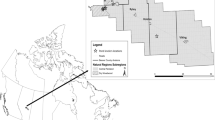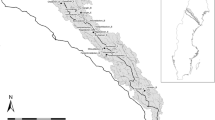Abstract
Non-structural streambank stabilization, or bioengineering, is a common stream restoration practice used to slow streambank erosion, but its ecological effects have rarely been assessed. We surveyed bank habitat and sampled bank macroinvertebrates at four bioengineered sites, an unrestored site, and a comparatively less-impacted reference site in the urban Peachtree-Nancy Creek catchment in Atlanta, GA, USA. The amount of organic bank habitat (wood and roots) was much higher at the reference site and three of the bioengineered sites than at the unrestored site or the other bioengineered site, where a very different bioengineering technique was used (“joint planting”). At all sites, we saw a high abundance of pollution-tolerant taxa, especially chironomids and oligochaetes, and a low richness and diversity of the bank macroinvertebrate community. Total biomass, insect biomass, and non-chironomid insect biomass were highest at the reference site and two of the bioengineered sites (p < 0.05). Higher biomass and abundance were found on organic habitats (wood and roots) versus inorganic habitats (mud, sand, and rock) across all sites. Percent organic bank habitat at each site proved to be strongly positively correlated with many factors, including taxon richness, total biomass, and shredder biomass. These results suggest that bioengineered bank stabilization can have positive effects on bank habitat and macroinvertebrate communities in urban streams, but it cannot completely mitigate the impacts of urbanization.



Similar content being viewed by others
Literature Cited
Abernethy B., I. D. Rutherford. 1998. Where along a river’s length will vegetation most effectively stabilize stream banks? Geomorphology 23:55–75
Benke A. C. 1984. Secondary production of aquatic insects. in V. H. Resh D. M. Rosenberg (eds.), The ecology of aquatic insects. New York, Praeger Publishers. Pages 298–322
Benke A. C. 2001. Importance of flood regime to invertebrate habitat in an unregulated river-floodplain ecosystem. Journal of the North American Benthological Society 20:225–240
Benke A. C., T. C. Van Arsdall Jr., D. M. Gillespie, F. K. Parrish. 1984. Invertebrate productivity in a subtropical blackwater river: The importance of habitat and life history. Ecological Monographs 54:25–63
Benke A. C., R. L. Henry III, D. M. Gillespie, R. J. Hunter. 1985. Importance of snag habitat for animal production in Southeastern streams. Fisheries 10:8–13
Benke A. C., A. D. Huryn, L. A. Smock, J. B. Wallace. 1999. Length-mass relationships for freshwater macroinvertebrates in North America with particular reference to the southeastern United States. Journal of the North American Benthological Society 18:308–343
Bledsoe B. P., C. C. Watson. 2001. Effects of urbanization on channel instability. Journal of the American Water Resources Association 37:255–270
Booth D. B. 2005. Challenges and prospects for restoring urban streams: a perspective from the Pacific Northwest of North America. Journal of the North American Benthological Society 24:724–737
Booth D. B., C. R. Jackson. 1997. Urbanization of aquatic systems: degredation thresholds, stormwater detection, and the limits of mitigation. Journal of the American Water Resources Association 33:1077–1090
Borchardt D. 1993. Effects of flow and refugia on drift loss of benthic macroinvertebrates: implications for habitat restoration in lowland streams. Freshwater Biology 29:221–227
Brown, K. 2000. Urban stream restoration practices: An initial assessment. Ellicott City, MD, US EPA Office of Wetlands, Oceans, and Watersheds: 87 pp
Grimm N. B., R. W. Sheibley, C. L. Crenshaw, C. N. Dahm, W. J. Roach, L. H. Zeglin. 2005. N retention and transformation in urban streams. Journal of the North American Benthological Society 24:626–642
Groffman P. M., A. M. Dorsey, P. M. Mayer. 2005. N processing within geomorphic structures in urban streams. Journal of the North American Benthological Society 24:613–625
Henderson J. E. 1986. Environmental designs for streambank protection projects. Water Resources Bulletin 22:549–558
Jones R. C., C. C. Clark. 1987. Impact of watershed urbanization on stream insect communities. Water Resources Bulletin 23:1047–1054
Larson M. G., D. B. Booth, S. A. Morley. 2001. Effectiveness of large woody debris in stream rehabilitation projects in urban basins. Ecological Engineering 18:211–226
Lenat D. R., J. K. Crawford. 1994. Effects of land use on water quality and aquatic biota of three North Carolina Piedmont streams. Hydrobiologia 294:185–199
Li M.-H., K. E. Eddleman. 2002. Biotechnical engineering as an alternative to traditional engineering methods: A biotechnical streambank stabilization design approach. Landscape and Urban Planning 60:225–242
Linhart J., S. Vlckova, V. Uvira. 2002. Bryophytes as a special mesohabitat for meiofauna in a rip-rapped channel. River Research and Applications 18:321–330
MAUWI. 1998. Watershed Management Guidance Document, Metro Atlanta Urban Watersheds Initiative. Prepared for City of Atlanta Department of Public Works, Division of Wastewater Services. Prepared by CH2MHILL in association with W.L. Jordan and R&D Environmental, June 1998
Merritt, R. W., and K. W. Cummins. 1996. an introduction to the aquatic insects of North America. Dubuque, IA, Kendall/Hunt Publishing Company. 862 pp
Meyer J. L., M. J. Paul, W. K. Taulbee. 2005. Stream ecosystem function in urbanizing landscapes. Journal of the North American Benthological Society 24:602–612
Michener W. K. 1997. Quantitatively evaluating restoration experiments: Research design, statistical analysis, and data management considerations. Restoration Ecology 5:324–337
Moerke A. H., G. A. Lamberti. 2003. Responses in fish community structure to restoration of two Indiana streams. North American Journal of Fisheries Management 23:748–759
NCDENR. 2003. Ecological functions of restored stream systems: Benthic Macroinvertebrates: Final Report for EPA Wetland Program Development Grant CD984487-98. Raleigh, NC, North Carolina Department of Environmental and Natural Resources: 29 pp
Paul M. J., J. L. Meyer. 2001. Streams in the urban landscape. Annual Review of Ecology and Systematics 32:333–365
Peckarsky B. L., P. R. Fraissinet, M. A. Penton, D. J. Conklin Jr. 1990. Freshwater Macroinvertebrates of Northeastern North America. Ithaca, NY, Cornell University Press. 442 p.
Rempel L. L., J. S. Richardson, M. C. Healey. 1999. Flow refugia for benthic macroinvertebrates during flooding of a large river. Journal of the North American Benthological Society 18:34–48
Rose S., N. E. Peters. 2001. Effects of urbanization on streamflow in the Atlanta area (Georgia, USA): a comparative hydrological approach. Hydrological Processes 15:1441–1457
Roy A. H., A. D. Rosemond, D. S. Leigh, M. J. Paul, J. B. Wallace. 2003. Habitat-specific responses of stream insects to land cover disturbance: biological consequences and monitoring implications. Journal of the North American Benthological Society 22:292–307
Schaefer J. W. 2000. Live staking with willows fails to protect eroded lakeshore slope (Alberta). Ecological Restoration 18:267–268
Schumm S. A. 1985. Patterns of alluvial rivers. Annual Review of Earth and Planetary Science 13:5–27
Shields F. D., S. S. Knight, N. Morin, J. Blank. 2003. Response of fishes and aquatic habitats to sand-bed stream restoration using large woody debris. Hydrobiologia 494:251–257
Sudduth, E. B. 2004. Effects of bioengineered bank stabilization on urban streams. Ecology. Athens, GA, University of Georgia: 141 pp
Suren A. M., S. McMurtrie. 2005. Assessing the effectiveness of enhancement activities in urban streams: II. Responses of invertebrate communities. River Research and Applications 21:439–453
Thorp J. H., A. P. Covich. 1991. Ecology and classification of North American freshwater invertebrates. New York, Academic Press, Inc. 911 p
Trimble S. W. 1997. Contribution of stream channel erosion to sediment yield from an urbanizing watershed. Science 278:1442–1444
Walsh C. J., T. D. Fletcher, A. R. Ladson. 2005a. Stream restoration in urban catchments through redesigning stormwater systems: looking to the catchment to save the stream. Journal of the North American Benthological Society 24:690–705
Walsh C. J., A. H. Roy, J. W. Feminella, P. D. Cottingham, P. M. Groffman, R. P. Morgan II. 2005b. The urban stream syndrome: current knowledge and the search for a cure. Journal of the North American Benthological Society 24:706–723
Washington H. G. 1984. Diversity, biotic, and similarity indices: A review with special relevance to aquatic ecosystems. Water Research 18:653–694
Whipple W. Jr., J. M. DiLouie, T. Pytlar Jr. 1981. Erosion potential of streams in urbanizing areas. Water Resources Bulletin 17:36–45
Wood P. J., P. D. Armitage. 1997. Biological effects of fine sediment in the lotic environment. Environmental Management 21:203–217
Acknowledgments
This project was completed with funding from the Charles S. Mott Foundation to the National River Restoration Science Synthesis project. E. S. Bernhardt, D. S. Leigh, and J. B. Wallace offered comments that helped shape this article. The reviews of D. B. Booth and two anonymous reviewers greatly improved this article. L. Burke, K. Loggins, A. Meadows, I. Mixon, J. Norman, B. Shea, and R. Treuer provided invaluable field and laboratory assistance.
Author information
Authors and Affiliations
Corresponding author
Rights and permissions
About this article
Cite this article
Sudduth, E.B., Meyer, J.L. Effects of Bioengineered Streambank Stabilization on Bank Habitat and Macroinvertebrates in Urban Streams. Environmental Management 38, 218–226 (2006). https://doi.org/10.1007/s00267-004-0381-6
Published:
Issue Date:
DOI: https://doi.org/10.1007/s00267-004-0381-6




